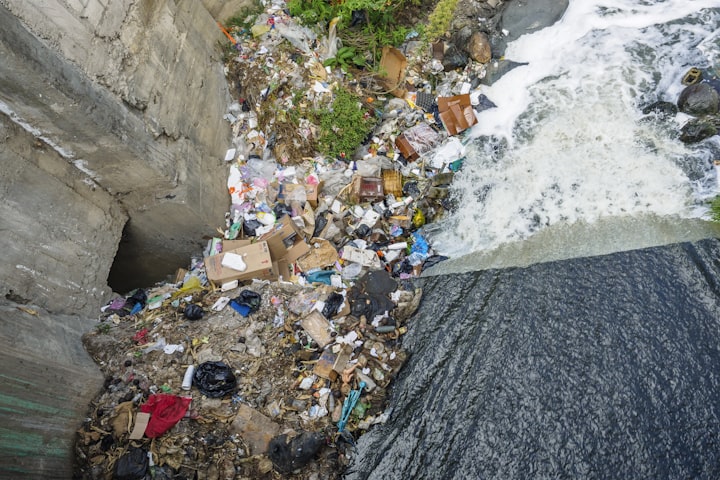Our Environment
Our Environment - The Hanford Site Example

Waste. Hazardous materials. Toxins all around us.
There are efforts to clean them up. Are they enough? Maybe our thinking need to change what do we make and how and why do we make them? From clothing to nuclear weapons. From plastic to drain cleaners. What are the things that we actually need to stay happy and healthy on our earth? I would like to share a little about the Hanford site in Washington State. This is just an example. Examples of waste exists are all over the world.
Washington State belongs to Region 10 for the Environmental Protection Agency (EPA). In 2013–2014 the EPA created the Environmental Justice Strategic Roadmap to address and eliminate issues of injustice and create "fair treatment" to all (EPA, 2012, b). The focus was on minorities and populations with low income, elderly, children, disadvantaged communities (EPA, 2012, b). Issues in the region include limited cleanup of contaminated sites, limited health resources, climate change issues, and animal feeding operation problems (EPA, 2012, b). Benton county, WA the Hanford Nuclear Reservation sites used to make plutonium to use in nuclear weapons for over 40 years; causing groundwater and soil contamination with radioactive waste that goes into Columbia River used for drinking water, half million people's lives can be affected (The Western Front, 2013, a & EPA 2020). The contaminated materials stored in tanks that are underground (EPA, 2020).
Hanford includes a 586 square mile area cleanup site, the area clean up started in 1989 where 43 million cubic yards of waste has been removed including 130 million cubic yard of soil that was contaminated (EPA, 2014, a & EPA 2020). Looking at the groundwater contamination in Hanford there is a continuing monitor system is in place by the Department of Ecology (DOE) to see if the radiological plumes reach and impact the Columbia River (DOE-WA, 2014). There are multiple areas that are monitored including area 200 which currently contains 56 million gallons of nuclear waste (EPA, 2020). Contaminants that are present in the area monitored include strontium-90, iodine-129, Tritium, Uranium, Technetium-99, Chromium, Carbon Tetrachloride and Nitrate; some of these contaminants are reaching the Columbia River (DOE-WA, 2014; EPA 2020). There is a contamination of water, soil, air and food at Hanford and surrounding areas (Grossman, Nussbaum, & Nussbaum, 2003).
The Risk Assessment Information System (RAIS) provides toxicity profiles of hazardous contaminants. Strontium-90 for example is a radioactive isotope with a half life of 28 years (RAIS, 2020). Strontium-90 is absorbed into a body by our lungs or digestive system and gets into the bones (RAIS, 2020) This chemical is classified as a class A carcinogen by the EPA (RAIS, 2020). In higher exposures to the toxin it causes bleeding and the person dies from a hemorrhagic syndrome while in lower exposures it destroys the bones and bone marrow, causes cancer (RAIS, 2020).
The health effects of the Hanford nuclear plant and waste facility and leaking nuclear waste and radiation include possible cellular death, chromosomal malfunction, cancer including thyroid cancer, central nervous system neoplasms, breast, colon, reproductive system cancers for women including cancers in the uterus, the ovaries, the cervix, the breasts (Grossman, Nussbaum, & Nussbaum, 2003 & Tenney, n.d.). Additionally, hypothyroidism, allergies, autoimmune disorders, fatigue, heart problems, abortions, infant mortality and birth defects can be caused by the nuclear waste (Grossman, Nussbaum, & Nussbaum, 2003 & Tenney, n.d.& RAIS 2020).
Communities affected by the exposure from Hanford are called "downwinder" communities exposed to radioactive materials. I have found many conflicting information in regards to Hanford and many different agency sites have deleted prior information that was referenced before. There was a thyroid disease study that showed that there are no problems occurring in Hanford more than anywhere else this was a 9 year study that upon publishing created a great controversy as people who are Hanford downwinders started to speak up in controversy (Pritkin, 2000). Pritkin is a sole survivor from cancers and thyroid disease is a downwinder, Pritkin's father, mother and brother all died of cancers, she states that many other families she know died the same way (Pritkin, 2000).
In 2013 there were still leaking tanks in Hanford, WA (Oregon Wand, 2013). What needs to be done is to continue risk assessment and risk management in the Hanford area in Washington state and surrounding effected areas where the downstream is going to prevent future exposures and diseases of the public. There is no safe dose of carcinogenic agents like radioactive fallouts and nuclear waste sites that are not safe and leaking (Moeller, 2011). To reduce or eliminate the risk would be the most effective method to reduce exposure and potential future harm (Moeller, 2011). Currently there has been ongoing cleanup at the Hanford site (EPA, 2020, a). There are areas filled with soil, constructions that begin in 1995 and still in process, treatment of soil and safe disposal efforts had been made (EPA, 2020, a) The problem will still be continuing as the financial backup is not there to provide safe storage of nuclear waste and nuclear power plants and radioactive materials are still produced in many place in the US and globally.
Thank you for reading,
Gabriella
All rights reserved. Dancing Elephants Press 2021.
References
Department of Ecology State of Washington (2014). Groundwater Contamination at Hanford. Retrieved from http://www.ecy.wa.gov/programs/nwp/gwhanfordcont.htm
EPA (2014, a). Region 10; Pacific Northwest. Hanford-Washington. Retrieved from http://yosemite.epa.gov/r10/cleanup.nsf/sites/hanford
EPA (2012, b). Environmental Justice Strategic Roadmap. Retrieved from http://www.epa.gov/region10/pdf/ej/EJ_Roadmap_RG_Final12-06-12.pdf
EPA (2020) Cleanups at Federal Facilities. Hanford site spotlight. retrieved from https://www.epa.gov/fedfac/hanford-site-spotlight
EPA (2020,a) Superfund site Hanford 200 - AREA Retrieved from https://cumulis.epa.gov/supercpad/SiteProfiles/index.cfm?fuseaction=second.Cleanup&id=1001105#bkground
Grossman, C., Nussbaum, R., & Nussbaum, F. (2003). Cancers among residents downwind of the Hanford, Washington, plutonium production site. Archives Of Environmental Health, 58(5), 267–274. Retrieved from http://web.a.ebscohost.com.ezp.waldenulibrary.org/ehost/detail?vid=3&sid=0924aca6-76e9-4ace-aa99-6df84790fdf%40sessionmgr4004&hid=4101&bdata=JnNpdGU9ZWhvc3QtbGl2ZQ%3d%3d#db=mnh&AN=14738272
Moeller, D. W. (2011). Environmental Health. (4th ed.). Cambridge, MA: Harvard University Press.
Oregon Wand (2013). Shut down Hanford nuclear plant. Retrieved from http://www.oregonwand.org/in-the-press/
Pritkin, T. (2000). Errors Found In Hanford Thyroid Disease Study. Retrieved from http://www.wagingpeace.org/articles/2000/01/00_pritikin_hanford-errors.htm#
The Risk Assessment Information System (2020). Retrieved from https://rais.ornl.gov/tox/profiles/strontium_90_c_V1.html
Tenney, S. (n.d.). The Public Health Impact of Hanford. Retrieved from http://www.psr.org/chapters/oregon/assets/pdfs/the-public-health-impact-of-1.pdf
The Western Front (2013, a). Senate Considers cleaning Washington State's toxic waste sites. Retrieved from http://www.westernfrontonline.net/news/article_4a142376-7d06-11e2-9472-001a4bcf6878.html?mode=image&photo=0
The Western Front (2013, b). Senate Considers cleaning Washington State's toxic waste sites. Retrieved from http://www.westernfrontonline.net/news/article_4a142376-7d06-11e2-9472-001a4bcf6878.html
About the Creator
Gabriella Korosi
I am a writer, public health professional, a nurse. Creator of connections, spreading positivity. Interests: health/spirituality/positivity/joy/caring/public health/nursing. My goal is to create positive change.https://gabriellakorosi.org






Comments
There are no comments for this story
Be the first to respond and start the conversation.